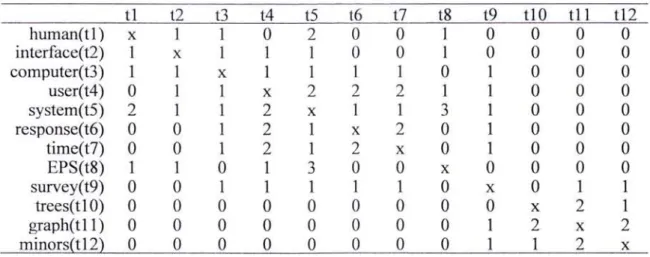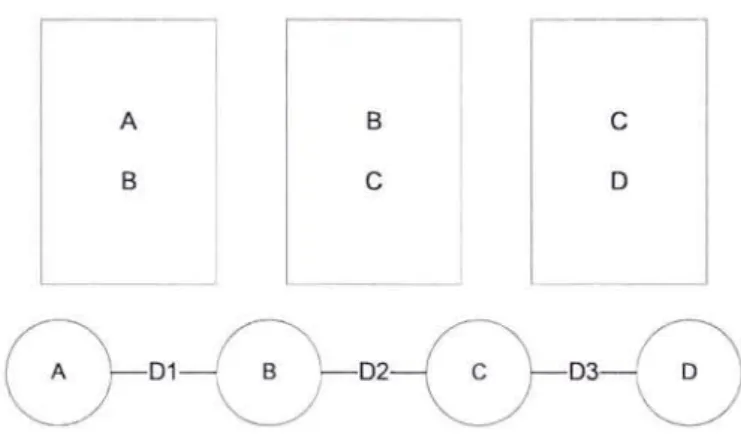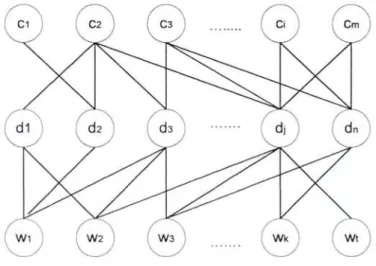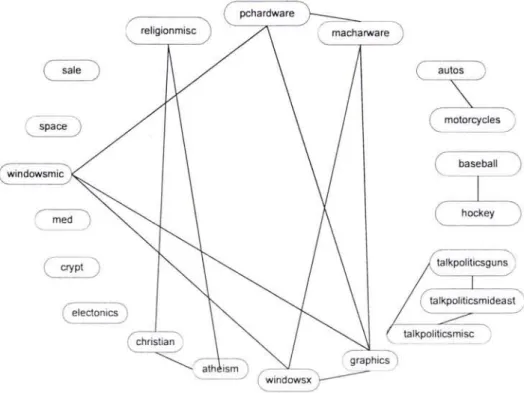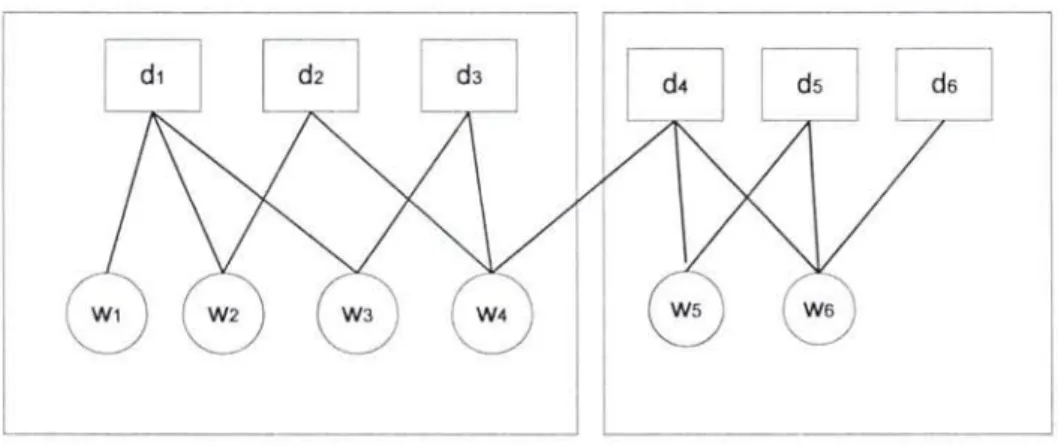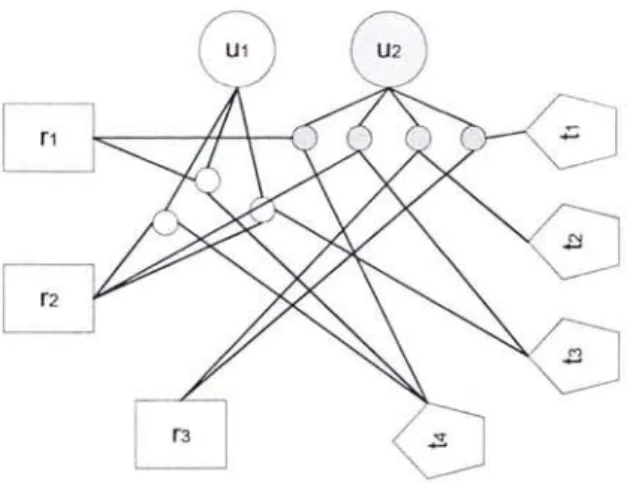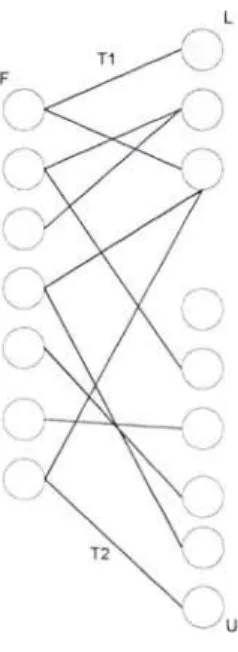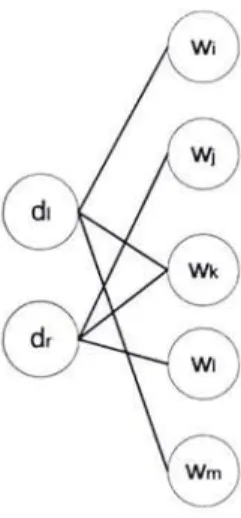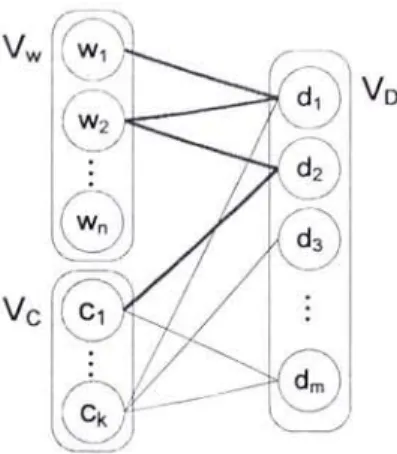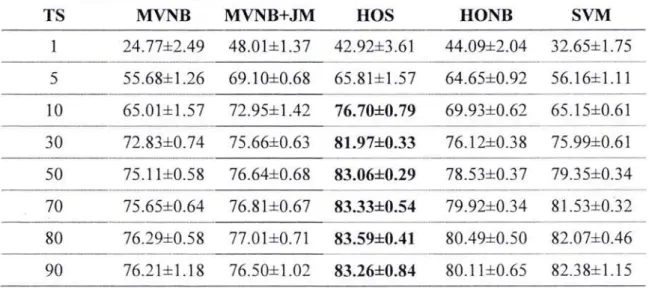T.C. DOGUŞ
UNIVERSITY
INSTITUTE OF.SCIENCE AND TECHNOLOGY
COMPUTER AND INFORMATION SCIENCES DEPARTMENT
HIGHER-ORDER SEMANTIC SMOOTHING FOR TEXT
CLASSIFICATION
M.S THESIS
Mitat POYRAZ
201091002
Thesis Advisor:
Assoc. Prof. Dr. Murat Can GANİZ
JANUARY 2013
ISTANBUL
.
T.C. DOGUŞ
UNIVERSITY
INSTITUTE OF SCIENCE AND TECHNOLOGY
COMPUTER
AND INFORMATION SCIENCES DEP ARTMENT
IDGHER-ORDER SEMANTIC SMOOTIDNG FOR TEXT
CLASSIFICATION
M.STHESIS
Mitat POYRAZ
201091002
Thesis Advisor:
Assoc. Prof. Dr. Murat Can
GANİZ
JANUARY
2013
ISTANBUL
~ -~---• • Doğuş Üniversitesi Kütüphanesi
111111111111111111111111111 11111111111111
1
111
*0
00
7
7
2
3
*
viı .. ,
HIGHER-ORDER SEMANTIC SMOOTHING FOR TEXT CLASSIFICATION
APPROVED BY:
Assoc. Prof. Dr. Murat Can GANİZ (Thesis Advisor)
Prof. Dr. Selim AKYOKUŞ
(Doğuş University)
Assoc. Prof. Dr. Yücel SAYGIN
(Sabancı University)
DATE OF APPROVAL: 29.01.2013
___s-~
PREFACE
In my thesis, a novel semantic smoothing method named Higher Order Smoothing (HOS) for the Na"ive Bayes algorithm is presented. HOS is built on a graph based data representation
which allows semantics in higher-order paths to be exploited. This work was supported in part by The Scientific and Technological Research Council of Turkey (TÜBİTAK) grant number 111E239. Points of view in this document are those of the authors and do not necessarily
represent the official position or policies of the TÜBİTAK.
Istanbul, January 2013 Mitat POYRAZ
ABSTRACT
Text classification is the task of automatically sorting a set of documents into classes ( or categories) from a predefined set. This task is of great practical importance given the massive volume of online text available through the World Wide Web, Internet news feeds, electronic mail and corporate databases. Existing statistical text classification algorithms can be trained to accurately classify documents, given a sufficient set of labeled training examples. However, in real world applications, only a small amount of labeled data is available because expert labeling of large amounts of data is expensive. in this case, making an adequate estimation of the model parameters of a classifier is challenging. Underlying this issue is the traditional assumption in machine learning algorithms that instances are independent and identically distributed (IID). Semi-supervised learning (SSL) is the machine learning concept concerned with leveraging explicit as well as implicit link information within data to provide a richer data representation for model parameter estimation.
it has been shown that Latent Semantic Indexing (LSI) takes advantage of implicit higher-order (or latent) structure in the association ofterms and documents. Higher-order relations in LSI capture "latent semantics". lnspired by this, a novel Bayesian frarnework for classifıcation named Higher Order Nai"ve Bayes (HONB), which can explicitly make use of these higher-order relations, has been introduced previously. in this thesis, a novel semantic smoothing rnethod named Higher Order Smoothing (HOS) for the Nai"ve Bayes algorithm is presented. HOS is built ona similar graph based data representation of HONB which allows semantics in higher-order paths to be exploited. Additionally, we take the concept one step further in HOS and exploited the relationships between instances of different classes in order to improve the parameter estimation when dealing with insufficient labeled data. As a result, we have not only been able to move beyond instance boundaries, but also class boundaries to exploit the latent information in higher-order paths. The results of experiments demonstrate the value of HOS on several benchmark datasets.
Key Words: Nai"ve Bayes, Sernantic Srnoothing, Higher Order Na"ive Bayes, Higher Order Smoothing, Text Classification
ÖZET
Metin sınıflandırma, bir dokümanlar kümesini daha önceden tanımlanan sınıflara ya da kategorilere otomatik olarak dahil etme işlemidir. Bu işlem, Web sayfalarında, Intemet haber kaynaklarında, e-posta iletilerinde ve kurumsal veri tabanlarında mevcut olan çok büyük miktardaki elektronik metin nedeniyle, giderek büyük önem kazanmaktadır.
Halihazırdaki metin sınıflandırma algoritmaları, yeterli sayıda etiketli eğitim kümesi verildiği taktirde dokümanları doğru sınıflandırmak üzere eğitilebilir. Oysaki gerçek hayatta, büyük miktarda verilerin uzman kişilerce etiketlenmesi pahalı olduğundan çok az sayıda etiketli veri mevcuttur. Bu durumda, sınıflandırıcının model parametreleri ile ilgili uygun bir kestirim yapmak zordur. Bunun temelinde, makine öğrenimi algoritmalarının, veri içerisindeki örneklerin dağılımının bağımsız ve özdeş olduğunu varsayması yatar. Yarı öğreticiyle öğrenme kavramı, model parametre kestirimi için, veri içerisindeki hem açık
hem de saklı ilişkilerden yararlanıp, onu daha zengin bir şekilde temsil etmeyle ilgilenir.
Saklı Anlam Indeksleme'nin (LSI) dokümanların içerdiği terimler arasındaki yüksek dereceli ilişkileri kullanan bir teknik olduğu ortaya konulmuştur. LSI tekniğinde kullanılan yüksek dereceli ilişkilerden kasıt, terimler arasındaki gizli anlamsal yakınlıktır. Bu teknikten esinlenerek, Higher Order Nai"ve Bayes (HONB) adı verilen, metnin içerisindeki yüksek dereceli anlamsal ilişkileri kullanan, yeni bir metod literatürde yer almaktadır. Bu tezde Higher Order Smoothing (HOS) adı verilen, Nai"ve Bayes algoritması için yeni bir anlamsal yumuşatma metodu ortaya konmuştur. HOS metodu, HONB uygulama çatısında yer alan, metin içerisindeki yüksek dereceli anlamsal ilişkileri kullanmaya imkan veren grafik tabanlı veri gösterimine dayanmaktadır. Ayrıca HOS metodunda, aynı sınıfların örnekleri arasındaki ilişkilerden faydalanma noktasından bir adım öteye geçilerek, farklı sınıfların örnekleri arasındaki ilişkilerden de faydalanılmıştır. Bu sayede, etiketli veri kümesinin yetersiz olduğu durumlardaki parametre kestirimi geliştirilmiştir. Sonuç olarak, yüksek dereceli anlamsal bilgilerden faydalanmak için, sadece örnek sınırlarının ötesine geçmekle kalmayıp aynı zamanda sınıf sınırlarının da ötesine geçebiliyoruz. Farklı veri kümeleriye yapılan deneylerin sonuçları, HOS metodunun değerini kanıtlamaktadır.
Anahtar Kelimeler: Nai"ve Bayes, Anlamsal Yumuşatma, Higher Order Na"ive Bayes, Higher Order Smoothing, Metin Sınıflandırma
ACKNOWLEDGMENT
I would like to express my deep appreciation and gratitude to my advisor, Yrd. Dr. Murat Can GANİZ, for the patient guidance and mentorship he provided to me, all the way from when I was first considering applying to the M.S program in the Computer Engineering Department, through to completion of this degree.
LIST OF FIGURES
Figure 2. 1 Example document collection (Deerwester et al., 1990) ... 4
Figure 2. 2 Deerwester Term-to-Term Matrix (Kontostathis and Pottenger, 2006) ... 5
Figure 2. 3 Deerwester Term-to-Term matrix (Kontostathis and Pottenger, 2006) ... 5
Figure 2. 4 Higher order co-occurrence (Kontostathis and Pottenger, 2006) ... 7
Figure 2. S The category-document-term tripartite graph (Gao et.al, 2005) ... 8
Figure 2. 6 Relationship-net for the 20NG <lata set (Mengle and Goharian, 2010) ... 9
Figure 2. 7 A bipartite graph of document and words ... 10
Figure 2. 8 Example of the tripartite network of social tagging system (Caimei et.al, 2011) ... 12
Figure 2. 9 Bipartite representation (Radev, 2004) ... 13
Figure 4. 1 Accuracy ofHOS, HONB and SVM on 20News-18828 ... 28
Figure 4. 2 Accuracy ofHOS, HONB and SVM on WebKB4 ... 30
Figure 4. 3 Accuracy of HOS, HONB and SVM on 1150Haber. ... 31
LIST OF T ABLES
Table 4. 1 Descriptions of the datasets with no preprocessing ...... 26
Table 4. 2 Accuracy and standard deviations of algorithms on 20 Newsgroups dataset ....... 28
Table 4. 3 Accuracy and standard deviations of algorithms on WebKB4 dataset.. ... 29
Table 4. 4 Accuracy and standard deviations of algorithms on 1150Haber dataset ... 30
Table 4. 5 Performance improvement of HOS over other methods on 20 Newsgroups ... 32
Table 4. 6 Performance improvement of HOS over other methods on WebKB4 dataset ....... 32
Table 4. 7 Performance improvement of HOS over other methods on 1150Haber dataset.. ... 32
Table 4. 8 F-measure performance of algorithms at 80% training set level ...... 33
Table 4. 9 AUC performance of algorithrns at 80% training set level.. .... 33
LIST OF SYMBOLS n(d, w;)
v
E G cp( w;, Dl)</J(D
J
)
<D(D) xı dTerm frequency of word w; in document d Vertex ofa graph
Edge ofa graph Tripartite graph
Number of higher-order paths between word w; and documents belongs to c1 Number of higher-order paths extracted from the documents of c
1
Number of higher-order paths between word w; and class label c J Number ofhigher-order paths between all terms and all class terms in D Boolean document-term <lata matrix
First-order co-occurrence matrix Second-order co-occurrence matrix Class-binarized <lata matrix
ABBREVIATIONS AUC CBSGC HONB HOS HOSVM IID IR JM k-NN LSI
MNB
MVNB NB ODP SOP SSL SVD SVM TF TS VSMArea Under the ROC Curve
Consistent Bipartite Spectral Graph Co-partitioning
Higher Order Nai've Bayes Higher Order Smoothing
Higher Order Support Vector Machines Independent and Identically Distributed Information Retrieval
Jelinek-Mercer Smoothing K-Nearest Neighbors Latent Semantic Indexing Multinomial Na"ive Bayes
Multivariate Bemoulli Nai've Bayes
Nai've Bayes
Open Directory Project Semi-definite Prograrnrning Semi-supervised Learning Singular Value Decomposition Support Vector Machines Term Frequencies
Training Set Size
Vector Space Model
T ABLE OF CONTENTS
PREFACE ... iii
ABSTRACT ... iv
ÖZET ... v
ACKNOWLEDMENT ... vi
LIST OF FIGURES ... vii
LIST OF TABLES ... viii
LIST OF SYMBOLS ... ix
ABBREVIA TIONS ... x
1. INTRODUCTION ... 1
1.1. Scope and objectives of the Thesis ... 1
1.2. Methodology ofthe Thesis ... 2
2. LITERA TURE REVIEW ... 3
3. METHODOLOGY ... 16
3 .1. Theoretical Background ... 16
3.2. Naıve Bayes Event Models ... 16
3.2.1. Jelinek-Mercer Smoothing ... 17
3.2.2. Higher Order Data Representation ... 18
3.2.3. Higher Order Na"ive Bayes ... 19
3.3. Higher Order Smoothing ... 20
4. CONCLUSION ... 25 4. 1. Experiment Results ... 25 4.2. Discussion ... 34 4.3. Future Work ... 35 REFERENCES ... 37 CV ... 41 xi
1. INTRODUCTION
1.1. Scope and objectives of the Thesis
A well-known problem in real-world applications of machine leaming is that they require a
large, often prohibitive, number of labeled training exarnples to leam accurately. However,
often in practice, it is very expensive and time consuming to label large amounts of data as
they require the efforts of skilled human annotators. In this case, making an adequate
estimation of the model parameters of a classifier is challenging. Underlying this issue is
the traditional assumption in machine learning algorithms that instances are independent
and identically distributed (IID) (Taskar et.al, 2002). This assumption simplifies the
underlying mathematics of statistical models and allows the classification of a single
instance. However in real world datasets, instances and attributes are highly
interconnected. Consequently, the IID approach does not fully make use of valuable
information about relationships within a dataset (Getoor and Diehl, 2005). There are
several studies which exploit explicit link information in order to overcome the
shortcomings of IID approach (Chakrabarti et.al, 1998; Neville and lensen, 2000; Taskar
et.al, 2002; Getoor and Diehl, 2005). However, the use of explicit links has a signifıcant
drawback; in order to classify a single instance, an additional context needs to be provided.
There is another approach which encounters this drawback, known as higher-order
learning. It is a statistical relational leaming framework which allows supervised and
unsupervised algorithms to leverage relationships between different instances of the same
class (Edwards and Pottenger, 2011 ). This approach makes use of implicit link information
(Ganiz et.al, 2006; Ganiz et.al, 2009; Ganiz et.al, 2011). Using implicit link information
within data provides a richer data representation. It is difficult and usually expensive to
obtain labeled data in real world applications. Using irnplicit links is known to be effective
especially when we have limited labeled data. In one of these studies, a novel Bayesian
frarnework for classification named Higher Order Nai"ve Bayes (HONB) has been
introduced (Ganiz et.al, 2009; Ganiz et.al, 2011). HONB is built on a graph based data
representation which leverages implicit higher-order links between attribute values across
different instances (Ganiz et.al, 2009; Lytkin, 2009; Ganiz et.al, 2011). These implicit links
2
text collection are richly connected by higher order paths of this kind. HONB exploits this rich connectivity (Ganiz et.al, 2009).
In this thesis, we follow the same practice of exploiting implicit link information by developing a novel semantic smoothing method for Naıve Bayes (NB). We call it Higher Order Smoothing (HOS).
1.2. Methodology of the Thesis
HOS is built on novel graph based <lata representation which is inspired from the <lata representation of HONB. However in HOS, we take the concept one step further and exploit the relationships between instances of different classes. This approach improves the parameter estimation in the face of sparse <lata conditions by reducing the sparsity. As a result, we move beyond instance boundaries and class boundaries as well to exploit the latent information in higher-order paths.
We perform extensive experiments by varying the size of the training set in order to simulate real world settings and compare our algorithm with different smoothing methods and other algorithms. Our results on several benchmark datasets show that HOS
significantly boosts the performance of Na"ive Bayes (NB) and on some datasets it even outperforms Support Vector Machines (SVM).
3
2. LITERA TURE REVIEW
Text classification is defined as the task of automatically assigning a document to one or
more predefined classes (or categories), based on its content. Documents are usually represented with the Vector Space Model (VSM) (Salton et al., 1975), a model borrowed from Information Retrieval (IR). In this model, documents are represented as a vector
where each dimension corresponds to a separate word in the corpus dictionary. Therefore,
the document is represented as a matrix where each row is a document and each colurnn is
a word. If a term occurs in the document then its value in the matrix is non-zero. In
literature, several different ways of computing these values, also known as term weights,
have been developed.
Generally, a large number of words exist in even a moderately sized set of documents; for
example, in one <lata set we use (WebKb4) 16,116 words exist in 4,199 documents.
However, each document typically contains only a small number of words. Therefore
document-term matrix is a high-dimensional, typically very sparse matrix with almost 99%
of the matrix entries being zero. Several studies have shown that, with the increase of
dimensionality, inference based on pairwise distances becomes increasingly difficult
(Beyer et.al, 1998; Verleysen and François, 2005). Although VSM is widely used, most of
the commonly used classification algorithms such as k-nearest neighbors (k-NN), Nai"ve
Bayesian and Support Vector Machines (SVM) rely on pairwise distances, hence suffer
from the curse of dimensionality (Bengio et.al,2006). In order to overcome this problem,
several approaches exploiting the latent information in higher-order co-occurrence paths
between features within datasets have been proposed (Ganiz et.al, 2009; Ganiz et.al, 2011).
The underlying analogy of the concept 'higher-order' is that human do not necessarily use
the same vocabulary when writing about the same topic. For example, in their study,
Lemaire and Denhier (2006) found 131 occurrences of word "internet", 94 occurrences of
word "web", but no co-occurrences at all, in a 24-million words French corpus from the
daily newspaper Le Monde. Obviously it can be seen that these two words are strongly
associated and this relationship can be brought to light if the two words co-occur with
other words in the corpus. For instance, consider a document set containing noteworthy
"microprocessor". We could infer that there is a conceptual relationship beween the
words "quantum" and "microprocessor", although they do not directly co-occur in any document. Relationships between "quantum" and "computer'', "computer" and
"microprocessor" is called as a first-order co-occurrence. The conceptual relationship
between "quantum" and "microprocessor" is called a second-order co-occurence which can be generalized to higher (3rd, 4th, 5th, ete) order co-occurrences. Many algorithms have been proposed in order to exploit higher-order occurences between words such as the Singular Value Decomposition (SVD) based Latent Semantic Indexing (LSI).
At the very basic level, we are motivated by the LSI algorithm (Deerwester et.al, 1990),
which is a widely used technique in text mining and IR. it has been shown that LSI takes advantage of implicit higher-order ( or latent) structure in the association of words and documents. Higher-order relations in LSI capture "latent semantics" (Li et.al, 2005). There are several disadvantages of using LSI in classification. it is a highly complex,
unsupervised, black box algorithm.
in their study, Kontostathis and Pottenger (2006) mathematically prove that LSI implicitly
depends on higher-order co-occurrences. They also demonstrate empirically that highe
r-order co-occurrences play a key role in the effectiveness of systems based on LSI. Terms
which are semantically similar lie closer to one another in the LSI vector space, so latent
relationships among terms can be revealed.
Titles: el: c2: c3: c4: c5: ml: m2: m3: m4:
Humanmachine interfacefor Lab ABC cornvuter applications
A survey of user opinion of computer system response time
The EPS user interface management system
Systern and human system engineering testing of EPS
Relation of user-perceived response time to error measurement The generation of random, binary, unordered trees
The intersection waph of paths in trees
Graph minors iV: Widths of trees and well-quasi-ordering
Graph minors: A survey
5 tl t2 t3 t4 t5 t6 t7 t8 t9 tlO tl l tl2 human(tl) x 1 1
o
2o
o
1o
o
o
o
interface(t2) l x 1 1 1o
o
1o
o
o
o
computer( t3) 1 l x 1 1 l 1o
lo
o
o
user(t4)o
1 1 x 2 2 2 1 1o
o
o
system(t5) 2 1 1 2 x l 1 3 1o
o
o
response(t6)o
o
1 2 1 x 2o
1o
o
o
time(t7)o
o
1 2 1 2 xo
1o
o
o
EPS(t8) 1 1o
1 3o
o
xo
o
o
o
survey(t9)o
o
1 1 1 1 1o
xo
1 1 trees(tlO)o
o
o
o
o
o
o
o
o
x 2 1 graph(tl 1)o
o
o
o
o
o
o
o
1 2 x 2 minors(t12}o
o
o
o
o
o
o
o
1 1 2 xFigure 2. 2 Deerwester Term-to-Term Matrix (Kontostathis and Pottenger, 2006)
tl t2 t3 t4 t5 t6 t7 t8 t9 tlO tl 1 tl2 human(tl) x 0.54 0.56 0.94 1.69 0.58 0.58 0.84 0.32 interface(t2) 0.54
x
0.52 0.87 1.50 0.55 0.55 0.73 0.35 computer(t3 0.56 0.52 x 1.09 1.67 0.75 0.75 0.77 0.63 0.15 0.27 0.20 user(t4) 0.94 0.87 1.09 x 2.79 1.25 1.25 1.28 1.04 0.23 0.42 0.31 system(t5) 1.69 1.50 1.67 2.79 x 1.81 1.81 2.30 1.20 response( t6) 0.58 0.55 0.75 1.25 1.81 x 0.89 0.80 0.82 0.38 0.56 0.41 time(t7) 0.58 0.55 0.75 1.25 1.81 0.89 x 0.80 0.82 0.38 0.56 0.41 EPS(t8) 0.84 0.73 0.77 1.28 2.30 0.80 0.80 x 0.46 survey(t9) 0.32 0.35 0.63 1.04 1.20 0.82 0.82 0.46 x 0.88 1.17 0.85 trees(tl O) 0.15 0.23 0.38 0.38 0.88 x 1.96 1.43 graph(tl 1) 0.27 0.42 0.56 0.56 1.17 1.96 x 1.81 minors(t12} 0.20 0.31 0.41 0.41 0.85 1.43 1.81 xFigure 2. 3 Deerwester Term-to-Term matrix (Kontostathis and Pottenger, 2006)
Let' s consider a simple document collection given in Figure 2. 1 where document el has
the words {human, interface} and c3 has {interface, user}. As can be seen from the
co-occurrence matrix in Figure 2.2, the terms "human" and "user" do not co-occur in this
example collection. After applying LSI, however, the reduced representation co-occurrence
matrix in Figure 2.3 has a non-zero entry for "human" and "user" thus implying a
similarity between the two terms. This is an example of second-order co-occurrence; in
other words, there is a second-order patlı between "human" in el and "user" in c3 through
6
, violating the IID assumption. The results of experiments reported in (Kontostathis and Pottenger, 2006) show that there is a strong correlation between second-order terrn co-occurrence, the values produced by SVD algorithm used in LSI, and the perforrnance of LSI measured in terrns of F-measure , the harrnonic mean of precision and recall. As noted, the authors also provide a mathematical analysis which proves that LSI does in fact depend on higher-order term co-occurrence (Ganiz et.al, 2011).
A second motivation stems from the studies in link mining which utilize explicit links (Getoor and Diehl, 2005). Several studies in this domain have shown that significant improvements can be achieved by classifying multiple instances collectively (Chakrabarti et.al, 1998; Neville and Jensen, 2000; Taskar et.al, 2002). However, use of explicit links requires an additional context for classification ofa single instance. This limitation restricts the applicability of these algorithms. There are also several studies which exploit implicit link information in order to improve the performance of machine learning models (Ganiz et.al, 2006; Ganiz et.al, 2009; Ganiz et.al, 2011). Using implicit link information within <lata provides a richer <lata representation and it is shown to be effective especially under the scarce training <lata conditions. In one of these a novel Bayesian framework for classifıcation named Higher Order Nai"ve Bayes (HONB) is introduced (Ganiz et.al, 2009;
Ganjz et.al, 2011 ).
HONB employs a graph based <lata representation and leverages co-occurrence relations between attribute values across different instances. These implicit links are named as higher-order paths. Attributes or features such as terms in documents of a text collection are richly connected by such higher-order paths. HONB exploits this rich connectivity (Ganiz et.al, 2009). Furthermore, this framework is generalized by developing a novel <lata driven space transforrnation that allows vector space classifiers to take advantage of relational dependencies captured by higher-order paths between features (Ganiz et.al, 2009). This led to the development of Higher Order Support Vector Machines (HOSVM) algorithm. Higher-order learning which a statistical relational learning framework consists of several supervised and unsupervised machine leaming algorithms in which relationships between different instances are leveraged via higher order paths (Li et.al, 2005; Lytkin, 2009; Edwards and Pottenger, 2011).
A B B c c o
()-
01
-
8
-
02
-0-
03-
8
Figure 2. 4 Higher order co-occurrence (Kontostathis and Pottenger, 2006)
7
A higher order path is shown in Figure 2.4 (reproduced from (Kontostathis and Pottenger,
2006)). This figure depicts three documents, Dl, D2 and D3, each containing two terms
represented by the letters A , B , C and D . Below tlıe three documents tlıere is a higlıer
order path tlıat links term A witlı term D througlı B and C. This is a third-order patlı since three links, or '·lıops," connect A and D. Similarly, tlıere is a second order patlı
between A and C througlı B . A co-occurs witlı B in document Dl , and B co-occurs
witlı C in document D2. Even if terms A and C never co-occur in any of the documents
in a corpus, the regularity of these second order paths may reveal latent semantic
relationship suclı as synonymy. As well as HONB, several studies in different areas of
natural language processing have employed graplı based data representation for decades.
These areas include, among otlıers, document clustering and text classification.
Text classification is the task of assigning a document to appropriate classes or categories
in a predefined set of categories. However, in tlıe real world, as the number of documents
explosively increases, the number of categories reaches a significantly large number so it
becomes much more difficult to browse and search tlıe categories. In order to solve this problem, categories are organized into a hierarchy like Open Directory Project (ODP) and
tlıe Yahoo! directory. Hierarchical classifiers are widely used wlıen categories are
organized in hierarchy; however, many data sets are not organized in hierarchical forms in real world.
8
To handle this problem, authors of the study (Gao et.al, 2005), propose a novel algorithm
to automatically mine hierarchical taxonomy from the data set in order to take advantage of
hierarchical classifier. In their approach, they model the relationship between categories,
documents and terms by a tripartite graph and partition it using consistent bipartite spectral
graph co-partitioning (CBSGC) algorithm. They use two bipartite graphs for representing
relationships between categories-documents and documents-terms. As can be seen in
Figure 2.5, a document is used asa bridge between these two bipartite graphs to generate a
category-document-term tripartite graph. CBSGC is a recursive algorithm to partition the
tripartite graph which terminates when subsets of the leaf nodes contains only one
category. Their experirnents show that, CBSGC discover very reasonable hierarchical
taxonomy and improves the classification accuracy on 20 Newsgroups dataset.
Figure 2. 5 The category-document-term tripartite graph (Gao et.al, 2005)
In another study, Mengle and Goharian (2010) intend to discover the relationships among
document categories which are represented in the form ofa concept hierarchy. In their
approach, they represent such relationships in a graph structure called Relationship-net
shown in Figure 2.6, where categories are the vertices of this graph and edges are the
relationship among them. In a category hierarchy, only the relationships among categories
sharing the same parent are represented. Therefore, identifying relationships among
non-sibling categories (categories with different parents) is limited. In Relationship-net,
relationships between non-sibling categories as well as sibling categories are presented so
9
relationships among categories, a text classifier's misclassification information is utilized. This approach relies on the fınding that categories which mostly are misclassified as each other indeed are relevant. They evaluate 20Newsgroup, ODP and SIGIR <lata sets in their experiments and results show that Relationship-net based on rnisclassification information statistically significantly outperforms the CBSCG approach.
autos motorcycles windowsmic talkpoliticsguns ( electonics) talkpoliticsmideast chris~
Figure 2. 6 Relationship-net for the 20NG data set (Mengle and Goharian, 2010)
Besides using graph structure in hierarchical taxonomy, several works employing graphs for clustering documents have been proposed. Clustering is the task of partitioning a set of objects into groups (or clusters) such that similar objects are in the same cluster while dissimilar objects are in different clusters. Homogeneous data clustering has been studied for years in the literature of machine learning and data rnining, however, heterogeneous data clustering has attracted more and more attention in recent years. Underlying this issue is that the sirnilarities among one type of objects sometimes can only be defined by the other type of objects especially when these objects are highly interrelated. For instance,
documents and terms in a text corpus, reviewers and movies in movie recommender systems, are highly interrelated heterogeneous objects. in these examples, traditional clustering algorithms might not work very well. In order to avoid this problem, many
10
researchers started to extend traditional clustering algorithms and propose graph partitioning algorithms to co-cluster heterogeneous objects simultaneously (Dhillon, 2001; Zha et.al, 2001).
In his study, Dhillon (2001) considers the problem of simultaneous co-clustering of documents and words. Most of the existing algorithms based on separate clustering, either documents or words but not sirnultaneously. Document clustering algorithms, cluster documents based upon their word distributions whereas word clustering algorithms uses words' co-occurrences in documents. Therefore, there is a dual relationship between document and word clustering as they both induce each other. This characterization is recursive because document clusters determine word clusters, which in tum determine (better) document clusters. In his approach, he represents a document collection as a bipartite graph shown in Figure 2. 7 and proposes an algorithm to sol ve this dual clustering problem.
ds
Figure 2. 7 A bipartite graph of document and words (Dhillon, 2001)
It is obvious that, better word and document clustering can be achieved by partitioning the graph such that the crossing edges between partitions have minimum weight. Therefore, simultaneous clustering problem become a bipartite graph partitioning problem. His algorithm partitions documents and words simultaneously by finding minimum cut vertex partitions in this bipartite graph, and provides good global solution in practice. He uses popular Medline (1033 medical abstracts), Cranfield (1400 aeronautical systems abstracts) and Cisi ( 1460 information retrieval abstracts) da ta sets in their experiments and his results verify that proposed co-clustering algorithm works well on real exarnples.
11
ln another study (Zha et.al, 2001 ), the authors also represent documents and terms as
vertices in a bipartite graph, where edges of the graph are the co-occurrence of the term
and document. In their approach, they propose a clustering method based on partitioning this bipartite graph. Unlike from (Dhillon, 2001), normalized sum of edge weights between unmatched pairs of vertices of the bipartite graph is minimized to partition the graph. They
show that, by computing partial SVD of the associated edge weight matrix of the bipartite
graph, an approximate solution to the minimization problem can be obtained. In their
experiments they apply their technique successfully on document clustering.
Clustering methods based on pair-wise similarity of data points, such as spectral clustering
methods require finding eigenvectors of the similarity matrix. Therefore, even though these methods shown to be effective on a variety of tasks, they are prohibitively expensive when
applying on large-scale text datasets. To tackle this problem, authors of the study (Frank
and Cohen, 2010), represent a text data set as a bipartite graph in order to propose a fast
method for clustering big text datasets. Documents and words correspond to vertices in the
bipartite graph and the number of paths between two document vertices is used as a
similarity measure. According to their results, even if proposed method runs much faster
from previous methods, it works as well as them in clustering accuracy.
As distinct from above studies clustering documents, authors of the study (Caimei et.al,
2011), propose a novel clustering method called "Tripartite Clustering" which clusters a
social tagging data set. Sets of users, resources and tags are elements of a social tagging
system hence it is naturally based on a tripartite form. In their tripartite graph
representation shown in Figure 2.8, each of these elements corresponds to vertices and a
vertex is characterized by its link to the other two types of vertices. They compare
Tripartite Clustering with K-means in their experiments and results show that, their method
12
Figure 2. 8 Example of the tripartite network of social tagging system (Caimei et.al, 2011)
Although there are several works for co-clustering two types of heterogeneous objects
( denoted by pair wise clustering) such as documents and terms, works for co-clustering more types of heterogeneous <lata ( denoted by higher-order clustering) is still very limited.
In their study, Gao et.al (2005) work on co-clustering higher-order objects in which there is a central object connecting the other objects so as to form a star structure. According to
them, this structure could be a very good abstract for real-world situations, such as co-clustering categories, documents and terms in text mining where the central object for the
star is documents. Their premise for the star structure is that, they treat co-clustering
categories, documents and terms problem as a union of multiple pair wise co-clustering problems with the constraint of the star structure. Therefore, they develop an algorithm
based on semi-definite programming (SDP) for efficient computation of the clustering
results. In their experiments on toy problems and real <lata, they verify the effectiveness of
their proposed algorithm.
Clustering algorithms are described as unsupervised machine learning algorithms because they are not provided with a labeled training set. On the other hand, Hussain and Bisson
(201 O) propose a two-step approach for expanding the unsupervised X-Sim co-clustering
algorithrn to deal with text classification task. In their approach, fırstly, they introduce a priori knowledge by introducing class labels into the training dataset while initializing
X-Sim. Underlying concept of this is that X-Sirn algorithrn exploits higher-order sirnilarities
within a <lata set hence adding class labels will force higher-order co-occurrences.
13
classes. Therefore, the influence of higher-order co-occurrences between documents in different categories is promoted. According to their experiment results, the proposed approach which is an extension of the X-Sim co-clustering algorithm gain perforrnance equal or berter to both traditional and state-of-the-art algorithms like k-NN, supervised LSI and SVM.
in another study, Radev (2004) proposes a tripartite updating method for a number classification task which is especially important in question answering systems. in his study, he defines a bipartite graph shown in Figure 2.9 where features are vertices and these vertices are connected with labeled and unlabeled examples.
Figure 2. 9 Bipartite representation (Radev, 2004)
in order to evaluate the perforrnance of proposed method, he compares tripartite updating with a weakly supervised classification algorithm based on graph representation, spectral partitioning. This algorithm is known as weakly supervised in the literature because it requires a small number of labeled examples. His experimental results show that, tripartite updating outperforrns spectral partitioning even though they both require minimal labeled <lata. The results also indicate that, both methods scale well to different ratios between the number of labeled training examples and the number of unlabeled examples.
14
The authors of study (Gharahmani and Lafferty, 2003) also use a weighted graph to
introduce a new classifıcation method based on the Gaussian random field. Labeled and unlabeled instances are the vertices of this graph where edge weights represent the
similarity between them. In order to identify the labeled node that is closest to a given unlabeled instance based on the graph topology, they apply belief propagation. They
perform experiments on text and digit classification and promising results demonstrate
that, proposed method has the potential to draw advantage from unlabeled data efficiently
to improve classification accuracy.
There are two commonly referred event models in Na'ive Bayes for text categorization;
multivariate Bemoulli (MVNB) and multinomial models (MNB). The first one is also
known as binary independence model. In this model presence and absence of the terms is
represented respectively "1" and "O". On the other hand in multinomial model is a unigram
language model with integer term counts. Thus, each class can be defıned as a multinornial
distribution. Multinornial model is actually a unigram language model (McCallum and Nigam, 1998). McCallum and Nigam (1998) compare multivariate Bemoulli and multinomial model on several different data sets. Their experimental results show that the multivariate Bemoulli event model represents berter performance at smaller vocabulary sizes, whereas the multinomial model generally performs well with large vocabulary sizes. Most of the studies about Nai"ve Bayes text classification employs multinomial model based on the recommendation of the well-known paper of McCallum and Nigam (McCallum and Nigam, 1998). However, there are some interesting studies using binary
data. For instance, MNB is shown to perform berter with binary data in some cases such as spam detection (Schneider, 2004; Metsis et.al, 2006). In another study Kim et.al (2006), propose a multivariate Poisson Na'ive Bayes text classification model with weight-enhancing method to improve performances on rare categories. Their experiments show
that, this model is a good altemative to traditional Na'ive Bayes classifier because it allows more reasonable parameter estimation when a low number of training documents is
available.
In general, NB parameter estimation drastically suffer from sparse data because it has so many parameters to estimate in text classification problems cıvııcı + ıcı) where ıvı denotes
ıs
the dictionary and
ICI
denotes the set of class labels (McCallum and Nigam, 1999). Mostof the studies on NB text classification employ Laplace smoothing by default. There are a few studies that attempt to use different smoothing methods. For instance Juan and Ney
(2002) use multinomial model with several different smoothing techniques which origin
from statistical language modeling field and generally used with n-gram language models.
These include absolute discounting with unigram backing-off and absolute discounting
with unigram interpolation. They state that absolute discounting with unigram interpolation
gives better results than Laplace smoothing. They alsa consider document length
normalization. Peng et.al (2004), augment NB with n-grams and advanced smoothing
methods from language modeling domain such as linear interpolation, absolute smoothing, Good-Turing Smoothing and Witten-Bell smoothing.
in another study (Chen and Goodman, 1998), authors propose a semantic smoothing
method based on the extraction of topic signatures. Topic signatures correspond to multi-word phrases such as n-grams or collocations that are extracted from the training corpus.
After having topic signatures and multiword phrases they used them in semantic smoothing
background collection model to smooth and map the topic signatures. They demonstrate that when the training data is small, the NB classifier with semantic smoothing
outperforms better than NB with background smoothing (Jelinek-Mercer) and Laplace
smoothing.
SVM is a popular large margin classifier. This machine learning method aims to fınd a decision boundary that separates points into two classes thereby maximizing margin (Joachims, 1998). SVM projects data points into a higher dimensional space so that the data points become linearly separable by using kemel techniques. There are several kemels
that can be used SVM algorithm. Linear kemel is known to perform well on text
16
3. METHODOLOGY
3.1. Theoretical Background
in this section we review the Na"ive Bayes event models and data representations. Although our method is not restricted to a particular application domain we focus on textual data.
3.2. Nalve Bayes Event Models
Na"ive Bayes is one of the most popular and commonly used machine leaming algorithms in text classification due to its easy implementation and low complexity. There are two generative event models that are cornmonly used with Na"ive Bayes (NB) for text classification. First and the less popular one is multivariate Bemoulli event model which is also known as binary independence NB model (MVNB). in this model, documents are considered as events and they are represented a vector of binary attributes indicating occurrence of terrns in the docurnent. Given a set of class labels C
=
{c1 , .... ,ek} and the corresponding training set D1 of docurnents representing classc1, for each j {1, .... ,K}.The probability that a document in class c1, will mention terrn wi. With this definition
(Chakrabarti, 2002),
(3.1)
Conditional probabilitiesP(w; 1 cJ are estimated by
(3.2)
which is ratio of the number of docurnents that contain terrn wi, in class c1, to the total
nurnber of docurnents in class c1. The constants in numerator and denominator in (3.2) are introduced according to Laplace's rule of succession in order to avoid zero-probability
17
terms (Ganiz et.al, 2009). Laplace smoothing adds a pseudo count to every word count. The main disadvantage of Laplace is to give too much probability mass to previously unseen events.
Second NB event model is multinornial model (MNB) which can make use of term frequencies. Let term w; occur n(d, w;) timesin document d, which is said to have length
f d
=
I
n(d, w;). With this defınition(3.3)
Class conditional term probabilities are estimated using (3.4).
(3.4)
where
IWI
is vocabulary (total number ofwords) (Chakrabarti, 2002).Because of sparsity in training data, missing terms (unseen events) in the document can
cause "zero probability problem" in NB. To eliminate this, we need to distribute some
probability mass to unseen terms. This process is known as smoothing. The most common
smoothing method in NB is Laplace smoothing. Formulas of the NB event modelsin (3.2)
and (3.4) already included Laplace smoothing. In the next section, we provide details ofa more advanced smoothing method which perform well especially on MVNB.
3.2.1. Jelinek-Mercer Smoothing
In Jelinek-Mercer smoothing method, the maxımum estimate is interpolated with the smoothed lower-order distribution (Chen and Goodman, 1998). This is achieved by linear
18
combination of maximum likelihood estimate in (3.5) with the collection model in (3.6) as shown in (3.7). In (3.6),
iDi
represents the whole training set, including the documents from all classes.iDi
:Lw;(d)
( 1 ) dED ·Pmı
W; c j =--ı-~-j.,-ı-
(3.5) (3.6) (3.7)3.2.2. Higher Order Data Representation
Data representation we built on is initially used in (Ganiz et.al, 2011 ). In this study, it is indicated that defınition ofa higher-order patlı is similar to the one in graph theory, which
states that given a non-empty graph G
=
(V,E) of the form V=
{x0,Xp····, xk},patlı P where the number of edges in P is its length.
A different approach is given in (Ganiz et.al, 2009) by using a bipartite graph. In this approach a bipartite graph G
=
(
(VD, Vıv)
,
E) is built from a set of D documents for a better representation. As it can be seen in Figure 3.1, in this graph, vertices in V0correspond to documents and vertices in V w correspond to terms.19
Figure 3. 1 Bipartite graplı representation of documents and terms
"There is an edge (d, w) between two vertices wlıere d E VD and w E Vw iff word w occurs in document d . In this representation, a higlıer-order patlı in dataset D can be
considered as a chain sub graplı of G. For example a chain w; - d1 - wk - dr - w1 whiclı is also denoted as ( w;, d" wk, dr,
w;)
is a second-order patlı since it spans througlı twodifferent document vertices. Higher-order patlıs simultaneously capture term co-occurrences
within documents as well as term sharing patterns across documents, and in doing so provide a muclı riclıer data representation than tlıe traditional feature vector form" (Ganiz
et.al, 2009).
3.2.3. Higher Order Na'ive Bayes
Riclı relational information between terms and documents can be exploited by using higlıer
order patlıs. In Higher Order Na'ive Bayes (HONB) tlıis valuable information is integrated
into multivariate Bernoulli Naıve Bayes algorithm (MNVB) by estimating parameters from
higlıer-order patlıs instead of documents (Ganiz et.al, 2009). Formulation of parameter
estimates are given in (3.8) and (3.9) whiclı are taken from (Ganiz et.al, 2009).
P(c
_
J
=
Kt/J(DJ)
LtfJ(Dk)
k=I
20
(3.9)
The number of higher-order paths containing term w; given the set of documents that belongs c 1 is represented by rp( w;,
D
1) . On the other hand,
r/J(D
1) denote the total numberof higher-order paths extracted from the documents of c
1. In (3.8) the Laplace smoothing is included in order to avoid zero probability problem for the terms that do not exist in c 1 .
3.3. Higher Order Smoothing
In this section we present a novel semantic smoothing method called Higher Order Smoothing (HOS) by following the same approach of exploiting implicit link information. HOS is built on a graph-based <lata representation from the previous algorithms in hjgher-order leaming framework such as HONB (Ganiz et.al, 2009; Garuz et.al, 2011). However, in HONB, higher-order paths are extracted in the context ofa class. Therefore we cannot exploit relations between terms and documents in different classes.
in HOS we take the concept one step further and exploit the relationships between instances of different classes in order to improve the parameter estimation. As a result, we are not only moving beyond document boundaries but also class boundaries to exploit the latent semantic information in higher-order co-occurrence paths between terms (Poyraz et.al, 2012). We accomplish this by extracting higher-order paths from the whole training set including all classes of documents. Our aim is to reduce sparsity especially in the face of insufficient labeled <lata conditions.
in order to do so, we first convert the nominal class attribute to a number of binary attributes each representing a class label. For instance, in WebKb4 dataset 'Class' attribute has the following set of values C
=
{
course, faculty, proje et, stajf, studen~. We add these four class labels as new terms (i.e. colurnns to our document by term matrix). We call them "class labels". Each of these labels indicates if the given document belongs to a particular class or not.21
After this transformation, we sliglıtly modify tlıe higlıer-order <lata representation by characterize a set of D documents as a tripartite graplı. In tlıis tripartite graplı
G
=
((Vw, Ve, Vv), E), vertices in VD correspond to documents, vertices in Vw correspond to terms, and finally vertices in Ve correspond to class terms or in otlıer words class labels. Figure 3.1 slıows suclı a tripartite graplı whiclı represents relationship between terms, classlabels, and documents. Similarly, to previous higlıer-order <lata representation with bipartite
graplı, a lıiglıer-order patlı in dataset D can be considered as a clıain sub graplı of G .
However, we are interested in suclı clıain sub graplıs that start with a term vertex from Vw,
spans througlı different document vertices in VD, and terminate witlı a class term vertex in
Ve . w; -d, -wk -d, -c1 is suclı a clıain wlıich we denote by (w;,d,, wk,d,,c). This chain corresponds to a second-order patlı since it spans througlı two document vertices.
Tlıese patlıs have potential to cross class boundaries and capture latent semantics. We enumerate higlıer-order patlıs between all tlıe terms in tlıe training set and tlıe class terms.
Tlıese higlıer-order paths capture tlıe term co-occurrences within a class of documents as well as term relation pattems across classes. As a result, tlıey provide more dense <lata representation tlıan the traditional vector space. This is the basis of our smoothing algorithm.
Let's consider w1 -d1 -w2 -d2 -c1 whiclı is an example chain is in tlıe tripartite graplı
given in Figure 3.2. This chain is indicated witlı red bold lines and it corresponds to a second-order patlı. in this example let' s assume that w1 never occurs in tlıe documents of c1•
We still can estimate parameter value of w1 for c1 using suclı paths. This is achieved by intermediate terms suclı as w2 tlıat co-occurs witlı w1 (given w2 occurs in the documents of
c1 ). As can be seen from the example, this new <lata representation and the new definition
of higher-order paths allow us to calculate class conditional probabilities for some of the terms that do not occur in documents of a particular class. This framework serves as a semantic smoothing method for estimating model parameters of previously unseen terms given the fact that higher-order paths reveal latent semantics (Kontostathis and Pottenger, 2006).
22
Vo
Figure 3. 2 Data representation for HO paths using tripartite graph (Poyraz et.al, 2012)
Based on this representation and modified definition of higher-order paths we can
formulate HOS. Let 8(w;,c) denote the number of higher-order paths that is between term
w; and class label cJ in the dataset D, and <l>(D) denote the total number of higher-order
paths between all terms and all class terms in D . Please note that D represents all
docurnents from all classes. This is one of the irnportant differences between the
formulation of HONB and HOS. The parameter estimation equation of the proposed HOS
is given in (3. 1 O). Although HOS has the potential to estirnate parameters for terms that do
not occur in the documents ofa class but occurs in other classes in training data, there can
be terms that occur only in test set. In order to avoid zero probability problems in these
cases, we apply Laplace smoothing in (3.10). Class priors are calculated according to
multivariate Bemoulli model using documents.
(3.10)
We recognize that different orders of paths may have different contribution to semantics
and provide even richer data representation. Similar to the linear interpolation (a.k.a.
Jelinek-Mercer) we can cornbine estimates calculated frorn different order of paths. In
(3. 11) the linear combination of first-order paths Gust co-occurrences) with second-order paths is shown. We use this formulation in our experiments. We set
fJ
to 0.5 experimentally23
P(wi 1
c
1 ) =(1-
/J)x
Pfo (wi 1c
1)+
/3
x
~
0
(wi
1c
1 ) (3.11)
The overall process of extracting second-order paths for HOS is described in Algorithm 1.
It is based on the enumeration algorithm proposed in (Ganiz et.al, 2009) which is described in detail in (Lytkin, 2009).
Algorithm 1 : Enumerating second-order paths for HOS
Jnput : Boolean document-term data Matrix X
=
X~Output: 02 matrix which stores the number of second-order paths in data Matrix X
1. Initialize vector ı =
(1
1, ••• ,l" ), which will store class labels of given data matrix X2. for each row i in data matrix X
2a. t =X'-1
1
3. Initialize class labels binary matrix C,6 = C,6: which will represent each class value as
binary where c is the number of classes in data matrix X
4. for each row i in C,6 matrix
4a. for each column c in
c
,"
matrix 4b. if /; is equal to j4c. set C,6(i,J) equal to 1
5. Compute matrix Xc16 = Xc16~+c by appending binary class valued matrix
c
,"
to data matrixx
6. Compute first-order co-occurrence matrix o, = x c/bT x c/b
7. Compute second-order co-occurrence matrix 02 = 0101
8. for each row i in first-order co-occurrence matrix 01
24
8b. Compute scalar s, to eliminate paths 11,d1,t1.dı,t3, where both docurnent vertices ( d1 ) are same
s
=
02(i,j)-(q (i,j)*(q (i,i)+ q (j,j)))8c. Update the element of second-order co-occurrence matrix, 02 (i, j)
=
02 (i,j)+
s9. Retum 02
In algorithrn 1, first, class labels are removed from given Boolean document-term <lata matrix and stored in a vector. Then, using class labels vector, a binary class labels matrix which represents each class value as binary, is built. Afterwards, class labels removed <lata matrix and binary class labels matrix are combined. In this instance, we have a new matrix called class-binarized matrix Xc16 which stores the input <lata matrix and its binary class values. We use Xc16 to calculate the first and second order paths. First order paths matrix is calculated by multiplying Xc16 by its transpose. Second order paths matrix is calculated by multiplying first order paths by itself. Finally, scalar s if computed in order to eliminate paths, where both docurnent vertices d1 are same and second order paths matrix is updated using this scalar value.
25
4. CONCLUSION
4.1. Experiment Results
In order to analyze the performance of our algorithm for text classification, we use three
widely used benchmark datasets. First one is a variant of 20 Newsgroups1 dataset. it is
called 20News-l 8828 and it has fewer documents from the original 20 Newsgroup dataset
since duplicates postings are removed. Additionally for each posting headers are deleted
except "From" and "Subject" headers. Our second dataset is the WebKB2 dataset which
includes web pages collected from computer science departments of different universities.
There are seven categories which are student, faculty, staff, course, project, department and
other. We use four class version of the WebKB dataset which is used in (McCallum and
Nigam, 1998). This dataset is named as WebK.B4. Third dataset is 1150Haber dataset
which consists of 1150 news articles in fi ve categories namely economy, magazine, health,
politics and sport collected from Turkish online newspapers (Amasyalı and Beken, 2009).
We particularly choose a dataset in different language in order to observe efficiency of
higher-order algorithms in different languages. Similar to LSI, we expect higher-order
paths based algorithms HONB and HOS to perform well on different languages without
any need for tuning. More information about this data set and text classification on Turkish
documents can be found in (Torunoğlu et.al, 2011 ). üne of the most important differences
between WebKB4 and other two datasets is the class distribution. While 20News-18828
and 1150Haber have almost equal number of docurnents per class, WebKB4 have highly
skewed class distribution. For the statistics given in Table 4.1, we apply no stemming or
stop word filtering. We only filter infrequent terms whose document frequency is less than
three. Descriptions of the datasets, under these conditions are given in Table 4. 1 including
number of classes
C\C\)
,
number of docurnentsC\D\)
and the vocabulary sizeC\V\)
.
1
http://people.csail.mit.edu/people/jrennie/20Newsgroups
Table 4. 1 Descriptions of the datasets with no preprocessing
DATA SET ıcı
iDi
20NEWS-l 8828 20 18,828 ... -... ·-··-··--···-·· WEBKB4 4 4,199 l 150HABER 5 1150 ıvı 50,570 16,116 11,038 26
As can be seen from Algorithm 1, complexity of the higher-order patlı enumeration algorithm is proportional to the number of terms. In order avoid wınecessary complexity and to finish experiments on time we reduce the dictionary size of all three datasets by applying stop word filtering and stemming using Snowball stemmer. Finally, dictionary sizes are fixed to 2,000 by selecting the most informative terms using Information Gain feature selection method. All of these preprocessing operations are widely applied in the literature and it has been known that they usually improve the performance of traditional vector space classifiers. For that reason, we are actually giving a considerable advantage to our baseline classifıer NB and SVM. Please note that HOS is expected to work well when the data is very sparse. In fact, these preprocessing operations reduce sparsity. As
mentioned before we vary the training set size by using following percentages of the <lata
for training and the rest for testing: 1 %, 5%, 10%, 30%, 50%, 70%, 80% and 90%. These percentages are indicated with "ts" prefıx to avoid confusion with accuracy percentages. We take class distributions into consideration while doing so. We run algorithms on 1 O random splits for each of the training set percentages and report average of these 1 O results augmented by standard deviations. While splitting data into training and test set, we employ stratified sampling. This approach is sirnilar to (McCallum and Nigam, 1998) and (Rennie et.al, 2003) where they use 80% of the data for training and 20% for test.
Our dataset include term frequencies (tf). However, higher-order paths based classifiers HONB and HOS currently can only work with binary data. Therefore they convert term frequencies to binary values in order to enumerate higher-order paths. We use up to second-order paths based on the experiment results of previous studies (Ganiz et.al, 2009; Ganiz et.al, 2011). Since we use binary data, our baseline classifier is multivariate Bemoulli NB (MVNB) with Laplace smoothing. This is indicated as MVNB in the results.
27
We alsa employ more advanced smoothing method with MVNB which is Jelinek-Mercer
(JM). Furthermore, we compare our results with HONB and state of the art text classifier
SVM. We used linear kemel in SVM since it has been known to perform well in text classification. Additionally, we optimize sofi margin cost parameter C by using the set of
{10-3 , .••• ,1,101, ••. ,103} of possible values. We picked the smallest value of C which resulted
in the highest accuracy. We observed that C value is usually 1 when the training data is
small ( e.g. up to 10%) and it is usually 10-2 when training data increase ( e.g. after 10%)
with the exception of 1150Haber which is our smallest dataset. In 1150Haber, best performing C value is 1 in all training set percentages except 90%.
We use accuracy augmented by standard deviations as our primary evaluation metric.
Tables show accuracies of algorithms. We only provide F-measure (Fl) and AUC values far 80% training data level due to length restrictions. However, we observe that they exhibit same pattems. We alsa provide statistical significance tests in several places by using Student's t-Test especially when accuracies of different algorithms are close to each other. We use a
=
0.05 significance level and consider the difference is statisticallysignificant if the probability associated with Student's t-Test is lower.
Our experiments show that HOS demonstrate remarkable performance on 20 Newsgroups dataset. This can be seen in Table 4.2 and Figure 4. 1. HOS statistically significantly outperforms our baseline classifier MVNB (with Laplace smoothing) by a wide margin in
all training set percentages. Moreover, HOS statistically significantly outperforms all other algorithms including NB with Jelinek-Mercer smoothing (MVNB+JM), HONB, and even SVM.
28
Table 4. 2 Accuracy and standard deviations of algorithms on 20 Newsgroups dataset
TS MVNB MVNB+JM HOS HONB SVM 1 24.77±2.49 48.01±1.37 42.92±3.61 44.09±2.04 32.65±1.75 ---··-···----··· ···-···-···- -5 55.68±1.26 69.10±0.68 65.81±1.57 64.65±0.92 56.16±1.11 ···-····-··----··· - - - - -···-···-··· ···-···-···---·-···---·-·-···-··-···-··· 10 65.01±1.57 72.95±1.42 76.70±0.79 69.93±0.62 65.15±0.61 - - - -··· ···-····--····-·--····-···- - - - -···-···-··· ···--···-··-···-··-···-···--···-···-··· 30 72.83±0.74 75.66±0.63 81.97±0.33 76.12±0.38 75.99±0.61 ···-···--···--···-··· -50 75.11±0.58 76.64±0.68 83.06±0.29 78.53±0.37 79.35±0.34 - - - - -··· .. ···-···-··-···- ···-··· 70 75.65±0.64
_____
76.81±0.67 83.33±0.54 79.92±0.34 81.53±0.32 ... _ 80 76.29±0.58 77.01±0.71 83.59±0.41 80.49±0.50 82.07±0.46 ---···-·--··-···-··--·--··-··· - - -90 76.21±1.18 76.50±1.02 83.26±0.84 80.11±0.65 82.38±1.15 20 News-18828 100 80··
•
·
..•
>-. 60 u "' :; u u <( 40 20 ···+···HOS - - -HONB ---svrvı o 1 5 10 30 50 70 80 90Training Set Percentage
Figure 4. 1 Accuracy ofHOS, HONB and SVM on 20News-18828
Table 4.3 and Figure 4.2 show the performance of HOS on WebKB4 dataset. Although not as visible as 20 Newsgroups dataset, HOS still outperforms our baseline MVNB starting from 10% training set level. The performance differences are statistically significant.
29
Additionally, HOS statistically significantly outperforms MVNB with JM smoothing
starting from 30% level. Interestingly, HONB performs slightly better than HOS on this
dataset. On the other hand SVM is significantly the best performing algorithm. We
attribute the better performance of HONB and especially SVM to the skewed class
distribution of the dataset. This the main difference of WebKB dataset from our other datasets.
Table 4. 3 Accuracy and standard deviations of algorithms on WebKB4 dataset
TS MVNB MVNB+JM HOS HONB SVM 44.48±1.03 69.96±3.15 30.08±6.56 70.58±3.80 60.57±1.82 ...
_________
.__
________
_
_ _
5 68.17±2.49 79.33±2.15 61.15±6.51 77.68±2.94 79.01±1.33 ... - - -- - · - - · · ···-····-···-·-···-··-···-···-- -- - -- -- - - -- -- - -10 74.46±1.36 80.76±1.54 77.71±2.33 80.83±1.35 83.48±1. 14 30 81.53±1.05 83.02±0.92 85.24±0.75 86.83±0.58 89.43±0.55 50 82.57±0.83 82.81±0.81 86.08±0.55 87.64±0.75 91.04±0.47 ···-···-···--- ... -.... ··-··--···-·· .. · · · · · -70 83.53±0.98 83.19±1.08 87.01±0.87 88.53±0.75 91.69±0.72 - -- -- ··· 80 83.14±1.17 82.85±1.23 86.47±1.25 88.79±0.85 91.78±0.64 90 84.17±2.10 83.41±1.61 87.01±1.20 88.36±1.42 92.20±1.00 WebKB4 100~-~---~----~----~ I / 60 I t 20 ···+ ···HOS - HONB - - -SVM o~~~----~---~----~---'---~ 1 5 10 30 50Training Set Percentage
